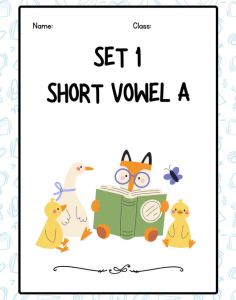
Phonics is very important for helping kids learn how letters and sounds are related. With 1st-grade phonics worksheets, kids may focus on recognizing sounds, putting letters together, and figuring out how to read simple words. These worksheets are meant to make learning fun, interactive, and useful so that kids can learn how to read on their own. Students acquire confidence in their ability to sound out words by doing phonics tasks every day. This is important for reading fluency.
Reading books to learn new words
Reading books for first graders helps kids learn new words in a way that makes sense. These books are deliberately made to be at the right level for first graders, so they can practice understanding what they read while having fun with stories that are easy to relate to. Kids who read these books a lot not only learn new words, but they also have a better idea of how sentences are put together and how to make a story. It’s important for kids to hear a lot of different words and phrases while they’re young so they may develop good communication skills that will help them in school and beyond.
Phonics worksheets for interactive learning
Students learn better when they work on 1st grade phonics worksheets. Worksheets frequently have exercises like matching letters to sounds, filling in missing vowels, and finding words that rhyme. These activities help kids learn to recognize letters and connect sounds to them, which are very important for reading well. These worksheets can help teachers and parents provide kids with rapid feedback, which can help them fix mistakes and make sure they really understand. These worksheets help you remember what you’ve learned by making you do the same thing over and over again.
Choosing the Best Books for Kids to Read
Picking the right reading books for first graders can have a big impact on how well they learn to read. Too easy novels could not be challenging enough, and too hard books might make children angry. It is vital to choose reading materials that are appropriate for a child’s level of understanding and progressively add words and sentences that are a little more difficult. Reading these novels out loud to kids also helps them with their pronunciation, fluency, and confidence. Students will be better able to handle more difficult literacy problems in the future if they read often.
Using books and worksheets together for the best results
Using phonics worksheets and reading books for 1st graders together is a great way to help them learn to read and write. Worksheets help kids practice the decoding abilities they learn via phonics, and reading books gives them real-world examples and situations to use those skills. Kids can connect the links between recognizing letters, making words, and understanding what they read when they do this. Teachers and parents who use both materials in a child’s learning routine generally see faster improvement and better reading skills.
Getting Kids to Love Reading Early
To raise lifelong readers, it’s important to make reading a fun and joyful experience. It is possible that using 1st grade phonics worksheets and 1st grade reading books daily activities help kids be more explorative, creative, and enthusiastic about the studies. Parents can enhance the likelihood of the child continuing to practice and improve by rewarding small achievements such as completion of a book or work sheet. The formation of these habits in the first grade is only the beginning of a successful life of school studies and of a lifetime of enjoyment of reading.
Conclusion
Parents and instructors who want to help kids learn to read and write early on need 1st grade phonics worksheets and 1st grade reading materials. Children learn important skills that will help them succeed by giving them controlled practice and interesting reading materials. You may get more resources and full learning materials at classroomcompanions.com. There, you can look through a wide range of worksheets and reading books that can make early learning exciting and successful.
